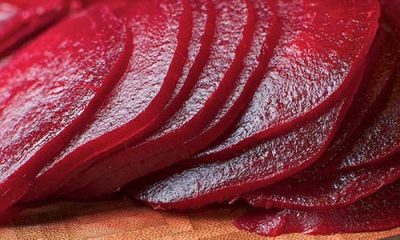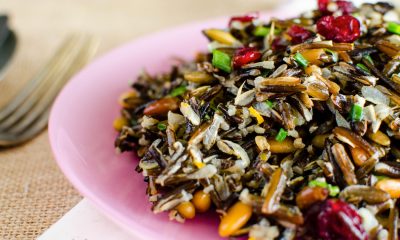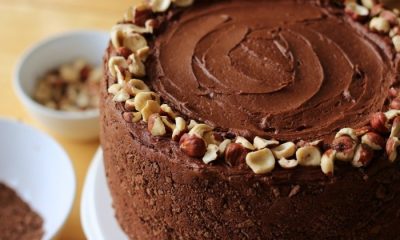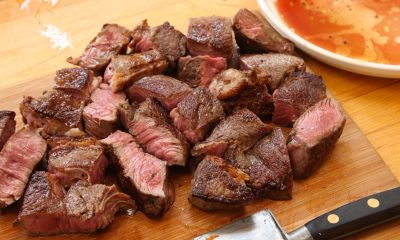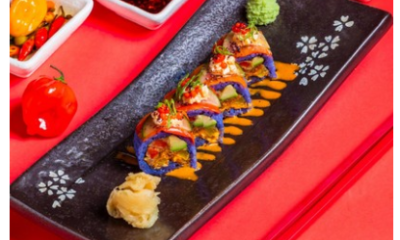Food Blogs
Bifteck Saute Au Beurre Recipe

| Servings |
MetricUS Imperial
|
- in One or two heavy skillets just large enough to hold the meat easilyone layer
- 1 ½ Tb butter and 1½ Tb oil or rendered fresh beef suet, more if needed
- 2 inch to 2½ lbs. steak ¾ to 1thick
- A hot platter
- salt and pepper
- cup ½stock canned beef bouillon, red wine, dry white wine, dry white vermouth, or water
- 2 to 3 Tb softened butter
Ingredients
|

|
- Put the butter and oil, or beef suet, in the skillet and place over moderately high heat until you see the butter foam begin to subside, or the beef fat almost smoking; this indicates the fat is hot enough to sear the meat. Sauté the steak on one side for 3 to 4 minutes, and regulate the heat so the fat is always very hot but is not burning. Turn the steak and sauté the other side for 3 to 4 minutes. The steak is done to a medium rare (à point) the moment you observe a little pearling of red juice beginning to ooze at the surface of the steak. Another test is to press the steak with your finger; it is medium rare when it just begins to take on a suggestion of resistance and spring in contrast to its soft raw state. If you have any doubts at all, cut a small incision in the steak.
- Remove the steak to a hot platter and season it quickly with salt and pepper. Keep warm for a moment while completing the sauce.
- Pour the fat out of the skillet. Add the liquid, and set the skillet over high heat. Scrape up coagulated juices with a wooden spoon while rapidly boiling down the liquid until it is reduced almost to a syrup. Off heat, swirl the butter into the liquid until it is absorbed; the butter will thicken the liquid into a light sauce. Pour the sauce over the steak and serve.
- [Pan-broiled Steak, with Shallot and White Wine Sauce]
- For broiled steak, use a beurre Bercy, and spread it over the steak just before serving.
- For 4 to 6 people, depending on your menu
- 2 to 2½ lbs. steak
- 1 Tb butter
- 3 Tb minced shallots or green onions
- Sauté the steak as described in the master recipe and remove it to a hot platter. Pour the fat out of the skillet. Add the butter. Stir in the shallots or onions and cook slowly for a minute.
- ½ cup dry white wine or dry white vermouth
- Pour the wine into the skillet and boil it down rapidly, scraping up the coagulated juices from the bottom of the pan until the liquid has reduced almost to a syrup.
- 4 to 6 Tb softened butter
- Salt and pepper to taste
- 2 to 3 Tb minced parsley
- Optional: 2 to 3 Tb diced, poached beef marrow
- Off heat, beat in the butter a spoonful at a time until it is absorbed and has thickened the sauce. Beat in salt and pepper to taste, then the parsley. Fold in the optional beef marrow. Spread sauce over the steak and serve.
- Bifteck Sauté à la Bordelaise
- [Pan-broiled Steak with Red Wine Sauce]
- Use the same procedure described for the preceding Bercy sauce, but substitute red wine for white. If you add the optional beef marrow, the sauce becomes a
KIND OF STEAK TO BUY:
In France you would select an entrecôte, romsteck, faux-filet, or bifteck. In America buy any tender, well-aged ¾- to 1-inch steak or steaks which will fit easily into a skillet such as:
Club or Delmonico Small Sirloin Tenderloin Butt
T-Bone Loin Strip Steak Rump Steak
Porterhouse Rib Steak Chuck Steak
AMOUNT TO BUY:
One pound of boneless steak will serve 2 people, 3 if the rest of the menu is copious. For large sirloins, T-bones, and porterhouse steaks, count on about ¾ pound per person.
PREPARATION FOR COOKING:
Trim off excess fat. Cut small incisions around the circumference of the steak wherever there is a layer of gristle, usually between the fat and the meat. This will prevent the steak from curling as it cooks. Dry the steak thoroughly on paper towels. It will not brown if it is moist.

